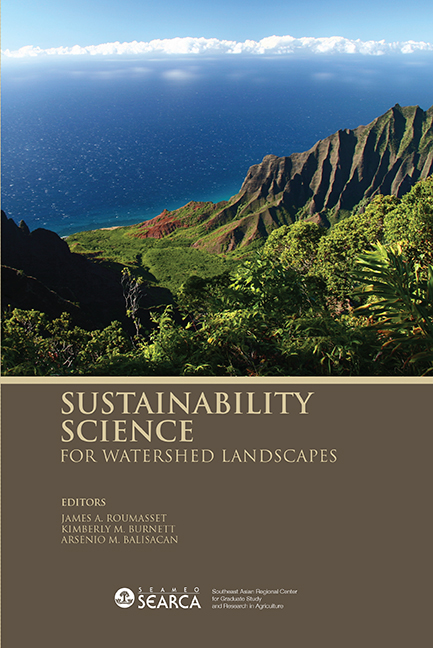Book contents
- Frontmatter
- Contents
- Tables
- Figures
- Message
- Foreword
- Preface
- Acknowledgments
- List of Contributors
- Theme 1 Sustainability Science for Resource Management and Policy
- Theme 2 Monitoring and Modelling
- Theme 3 Participatory Approaches
- Theme 4 Case Studies
- 10 Changing Land Use in the Golden Triangle: Where the Rubber Meets the Road
- 11 Effects of Feral Pigs (Sus scrofa) on Watershed Health in Hawaiʿi: A Literature Review and Preliminary Results on Runoff and Erosion
- 12 Sustainable Water Quality Management for Pacific Island Watersheds: Illustrations from American Samoa, Hawaiʿi, and Micronesia
- 13 The Transboundary Management of Groundwater Resources in Kumamoto, Japan
- Synthesis
11 - Effects of Feral Pigs (Sus scrofa) on Watershed Health in Hawaiʿi: A Literature Review and Preliminary Results on Runoff and Erosion
from Theme 4 - Case Studies
Published online by Cambridge University Press: 21 October 2015
- Frontmatter
- Contents
- Tables
- Figures
- Message
- Foreword
- Preface
- Acknowledgments
- List of Contributors
- Theme 1 Sustainability Science for Resource Management and Policy
- Theme 2 Monitoring and Modelling
- Theme 3 Participatory Approaches
- Theme 4 Case Studies
- 10 Changing Land Use in the Golden Triangle: Where the Rubber Meets the Road
- 11 Effects of Feral Pigs (Sus scrofa) on Watershed Health in Hawaiʿi: A Literature Review and Preliminary Results on Runoff and Erosion
- 12 Sustainable Water Quality Management for Pacific Island Watersheds: Illustrations from American Samoa, Hawaiʿi, and Micronesia
- 13 The Transboundary Management of Groundwater Resources in Kumamoto, Japan
- Synthesis
Summary
ABSTRACT
While there is a variety of anecdotal evidence, only a few studies have attempted to quantify the effects of feral pig activity on runoff and erosion in forested watersheds in Hawaiʿi. This chapter identifies the effects of feral pig activity on watershed attributes in general, with a literature search, and then specifically investigates the effects of feral pigs on runoff and soil loss within a forested watershed in Hawaiʿi through an experimental feral pig exclosure study.
Literature review indicates that feral pigs have adapted to a wide range of habitats in Hawaiʿi. They can reproduce rapidly and are capable of year round breeding. Feral pigs damage native plant communities and spread invasive plant species. They disrupt watershed hydrology by disturbing understory plant and litter layers and increasing soil compaction. Despite these impacts, feral pig eradication and control are complex cultural, political, and economic issues in Hawaiʿi. As total eradication is not likely a viable option, control methods include hunting, trapping, snaring, poisoning, and fencing. Optimal control should involve combinations of available methods and seek inputs from a wide range of stakeholders and local communities.
In the experiment, eight sites of various slopes were selected throughout the Mānoa watershed on the island of Oʿahu. On each site, paired fenced and unfenced runoff plots were constructed. Soil samples were collected from each plot in September 2007 to determine the baseline edaphic characteristics. Runoff from both plots was collected monthly from November 2007 to February 2008 following rain events and total suspended solids (TSS) in runoff were analysed. Results showed high variability in runoff and soil loss among different areas of the watershed and across the four months. Over the study period, unfenced plots generally exhibited decreasing soil cover and increasing TSS in runoff. In contrast, fenced plots displayed increasing vegetation cover and decreasing TSS in runoff. This initial data provides quantitative information on the effects of feral pigs on runoff and erosion in an watersheds. As the relationship between pigs and watershed damage becomes clearer, values can be assigned to policy instruments, such as fencing, in terms of avoided damages. This study provides some of the first data to characterise this relationship.
- Type
- Chapter
- Information
- Sustainability Science for Watershed Landscapes , pp. 251 - 278Publisher: ISEAS–Yusof Ishak InstitutePrint publication year: 2010

